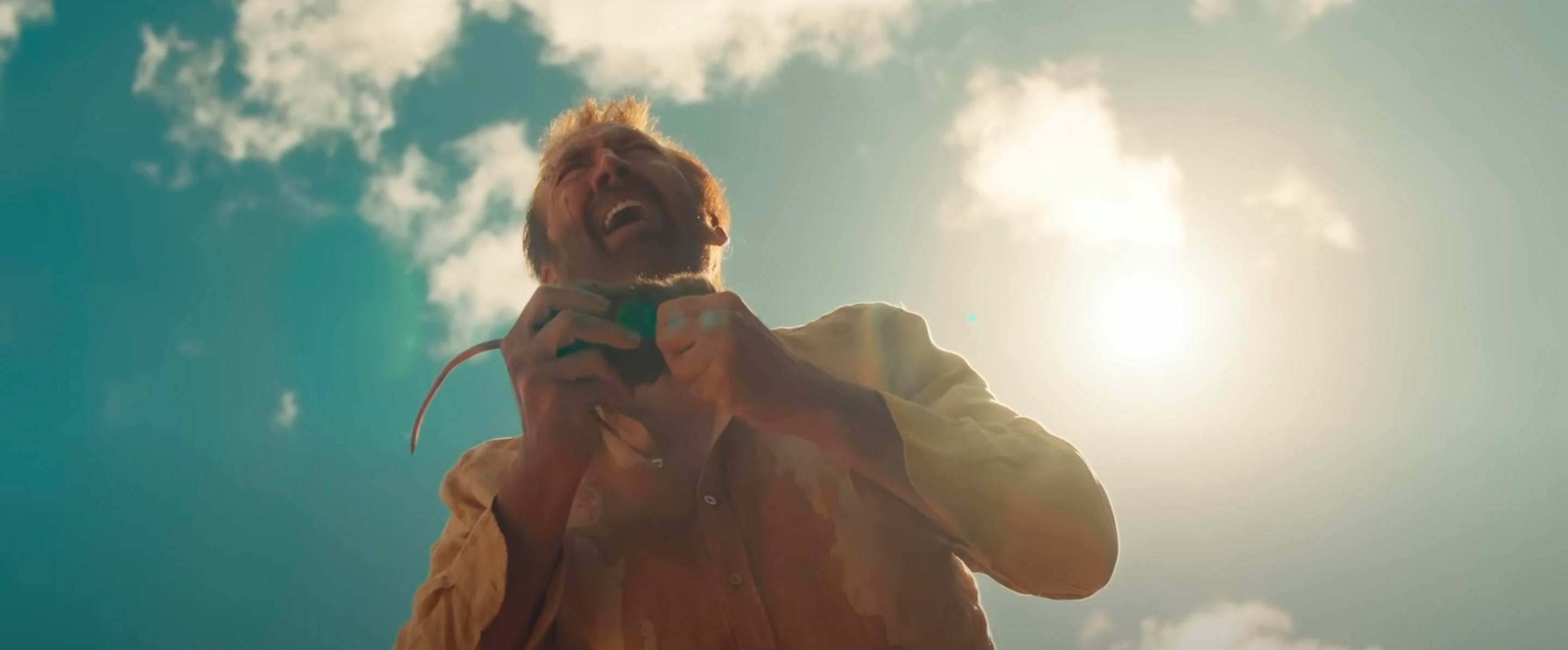
When you cast Nic Cage in a role, you’re going to get Nic Cage. And Lorcan Finnegan’s sun-soaked psychedelic thriller, The Surfer, makes no bones about that. Cage is as big as Cage can get, starring as a nameless man who gets slowly broken down mentally by a group of alpha-male surfers who rule a “locals only” beach on the coast of Australia.
But Cage doesn’t just see his role in The Surfer as part of a long line of over-the-top performances that have turned him into a cinematic icon. There’s an arc to this nameless Surfer, who starts the film as a suited businessman and ends as a foaming-at-the-mouth vandal.
“I always feel that it’s like music for me.”
“There is a transformation going on here,” Cage tells Inverse. “The character starts off as a fairly normal man, and then slowly, through a process of humiliations and degradations, he becomes the inner caveman.”

The unveiling of one’s “inner caveman” is the ultimate end goal of The Surfer’s antagonist, Scally (Julian McMahon), a cultish figure who runs the Bay Boys (the name the group of beach bullies call themselves) and who has acts as a self-help guru for men who have grown too “soft.” He sees that softness in Cage’s Surfer, and throughout the film, he and his Bay Boys put the Surfer through humiliation after humiliation — stealing his phone, stealing his car, starving and giving him heat stroke — until he’s a slobbering mess who begins to consider eating a dead rat. But Finnegan’s film unpacks their alpha-male ways, weaving a surprisingly timely story of toxic masculinity.
“That was always a theme within the film — about masculinity in crisis.”
“With The Surfer, that was always a theme within the film — about masculinity in crisis,” Finnegan tells Inverse. “It can’t be ignored that it exists, that obviously there’s a lot of guys out there who feel a little bit lost, they’re looking to belong to something.”
That’s when charismatic figures like Scally come in, who impress or even seduce these vulnerable young men. But Finnegan didn’t want Scally to be depicted as the outright villain — “It’s slightly ambiguous as to whether he is actually trying to help these guys, or if he’s actually a bad influence,” Finnegan says — instead, he’s there to “play a part in Nic’s Jungian journey through the film.”

The Surfer’s Jungian journey puts Cage through the wringer in the most repulsive way, with Cage engaging in some of the wildest gross-out scenes of his career. One scene that Finnegan fondly recalls is one that Cage partially improvised — in the script, his character is described only to be “rambling incoherently,” but Cage expanded upon that in the most disgusting way possible.
“I remember all of that was just a big improv-y fugue state that he got into for that scene,” Finnegan recalls. “And I had tears run down my cheeks from laughing at all the clams casino, puttanesca pasta, and all these things that were just coming out of his mouth. It was a delight.”

Cage’s improvised scenes provide some of the most deranged moments of the movie. Later in the film, as the Surfer is at his lowest point, he stuffs a rat down a man’s throat and screams, “Eat the rat!” — a scene that Cage has repeatedly said he improvised, having at one point decided to keep the rat prop in his pocket until he could think of something to do with it. It’s a scene that can’t help but remind you of all of Cage’s other over-the-top flairs that have made him such a star.
“I design where the top is in these cases.”
But when I asked Cage whether a script like The Surfer would give him pause because its “over-the-top” role could seem superficially similar to other bombastic turns he’s made in the past, Cage gave me a long, slightly rambling, answer so quintessentially Nic Cage that I feel the need to drop it below in its entirety:
I always feel that it’s like music for me. I can hear it where I want to go larger, so to speak. It doesn’t matter how large you go as long as it’s informed with genuine emotion, and even though it seems big or what you call over-the-top, in that situation, in that moment, under those circumstances, to me it seems believable and it seems thrilling and enthralled and galvanizing and electric and music. To go and say, “Eat the rat,” because you earned it. He earned that moment, and you, with me, went with me on that ride. You scratch the surface of any man or woman long enough, you will eventually reach the inner caveman, and that’s what’s happening here.
So I have musical bars, eight bars here. I’ll tell the director, “OK, this time we’ve been very quiet. He’s holding it in. When I get to the beach and I do it, I’m going to go all in and really scream,” because to me, it’s the right appropriate insane, angry, and heartbroken response after what he’s been through, to me. And so to me, it feels authentic, not, as you say, over-the-top. And by the way, I look around me all the time in days and life, and I see people do things that if you put it on camera, you would say that’s over-the-top. But people are doing it all the time, screaming in their car, driving at a stoplight, getting out, yelling at somebody in their car, putting the seat back just to stop the light and wait, take a breather before the light turns green, crazy stuff. But for me, I design where the top is in these cases. I look at it musically, and I look at it like choreography. I know when the character earns the right to go there, and I have an instinct that you will go there with me.
It’s a surprisingly thoughtful answer to a question that Cage must get a lot. But hey, he’s Nicolas Cage. He’s always going to surprise us and enchant us. And, like The Surfer and its rotting rat, we’ll eat it up every time.







